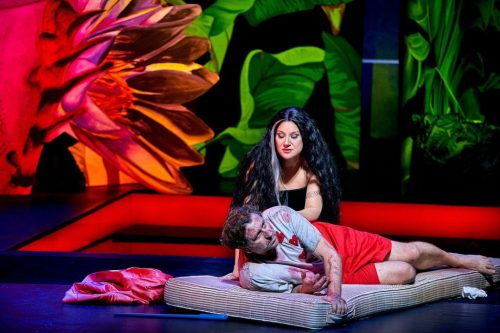
 Germany Bayreuth Festival 2023 [3] – Wagner, Parsifal: Soloists, Bayreuth Festival Chorus and Orchestra / Pablo Heras-Casado (conductor). Festspielhaus, Bayreuth, 15.8.2023. (MB)
Germany Bayreuth Festival 2023 [3] – Wagner, Parsifal: Soloists, Bayreuth Festival Chorus and Orchestra / Pablo Heras-Casado (conductor). Festspielhaus, Bayreuth, 15.8.2023. (MB)

Production:
Director – Jay Scheib
Designs – Mimi Lien
Costumes – Meentje Nielsen
Lighting – Rainer Casper
AR and video – Joshua Higgason
Dramaturgy – Marlene Schleicher
Chorus director – Eberhard Friedrich
Cast:
Amfortas – Derek Welton
Titurel – Tobias Kehrer
Gurnemanz – Georg Zeppenfeld
Parsifal – Andreas Schager
Klingsor – Jordan Shanahan
Kundry – Ekaterina Gubanova
Knights of the Grail – Siyabonga Maqungo, Jens-Erik Aasbø
Squires – Betsy Horne, Margaret Plummer, Jorge Rodriguez-Norton, Garrie Davislim
Flowermaidens – Evelin Novak, Camille Schnoor, Margaret Plummer, Julia Grüter, Betsy Horne, Marie Henriette Reinhold
Alto solo – Marie Henriette Reinhold
To move from Dmitri Tcherniakov’s gripping Flying Dutchman to Jay Scheib’s new and much- trumpeted, augmented reality-enhanced Parsifal veered towards regression from the sublime to the ridiculous. I should state that I was not one of those with the spectacles necessary to see the ‘enhanced’ version, my short-sightedness being (just) too severe. But since most in the Festspielhaus audience did not have the glasses, it does not seem unreasonable to write about what I could see, whilst noticing access issues that surely require resolution.
I wish I could tell you what Scheib’s production is about. It certainly does not seem to be founded on knowledge of, or even interest in, Wagner and Parsifal. ‘When I think of the word “Bühnenweihfestspiel,” Scheib tells us in the programme, ‘I think first of all about a celebration. We are opening a festival! Let’s get the party started!’ Leaving aside what is presumably an unintentional homage to the former Labour MP Keith Vaz, it is difficult to know where to start. Perhaps with advice to look up the ‘weih’ part of the word in a dictionary, and thereafter to consider what ‘consecration’ might entail. Or even just to acquaint oneself with the plot, let alone with Wagner’s writings. Good things can, of course, proceed from misunderstandings or misappropriations; the problem is that very little at all proceeds from this or from anything else.
What do we have, then? It looks somewhat like a computer game, I think, though I am hardly the best person to know. That, I suspect, is the ‘aesthetic’, but I may be wrong. What action there is unfolds against some of the most hideous designs I have had the misfortune to see, accompanied by apparently equally meaningless activity and lack of activity. Strange outfits sported by some of the knights in the first act suggest a directorial attempt to tell us he too has done some drugs in his time. I was unsure for a while whether the peculiar shapes on them were intended to evoke bacteria – wounds of their own? – but Gurnemanz’s sudden acquisition of them on a garish, presumably sacerdotal cloak and equally sudden dispensing of them suggested not. The poor souls looked like refugees from a discontinued children’s television programme. Earlier, indeed in the first-act Prelude, Gurnemanz has sex with a woman, tastelessly magnified on live camera. Who she is I have no idea, but she returns to stand and then walk around in the third act, before embracing him at the close.

Amfortas’s blood, not unreasonably, appears for a while to be a preoccupation, the wound rather monstrously magnified on camera during Gurnemanz’s first-act narration. Parsifal smashes the grail at the end, though with what import again I have no idea. Certain people walk around or wear slightly different clothes. There are two Kundrys, I think, one of whom is silent and sometimes mirrors the action of the other or sometimes just walks around in a circle. Others, above all Parsifal and Kundry in their great confrontation in the second act, seem entirely abandoned and have to fend for themselves. And the Barbie-meets-Benny Hill aesthetic of that act, sadly lacking the intellectual heft of either, is not an experience I should wish even on Mr Vaz. That Klingsor (Jordan Shanahan) wears heels seems a peculiar, carelessly offensive translation of self-castration. To be brutally honest, though, it is difficult to care. So boring, I am sad to say, was this hapless production that it almost had me long for the prior nadir of Uwe Eric Laufenberg’s staging (2016–19), though at least it had none of Laufenberg’s Islamophobia. Illumination such as that offered by Stefan Herheim (2008–12) will always remain a rare experience, but surely a director should be able to do, or at least try to do, better than this.
Sadly, this made it difficult, at least for me, to care much about, or even to attend to, the musical performances. Pablo Heras-Casado’s conducting was generally fluent enough on the micro-level but imparted little sense of a greater whole. String tone was sometimes strangely thin, though to his credit, Heras-Casado seemed largely to have the measure of the particular challenges presented by conducting in Bayreuth’s covered pit. The audience, though, was wildly enthusiastic. So too was it for most of the singers (with none of the incomprehensible booing heard the previous night). For me, insofar as I could tell beyond the production, they were more impressive than moving. Andreas Schager was his usual indefatigable self in the title role. We are lucky to have him and his seemingly boundless enthusiasm, although his voice is no longer so fresh as it was. Ekaterina Gubanova similarly gave much as Kundry; her attention to the equally exacting demands of words and music was noteworthy throughout. So too was Georg Zeppenfeld’s as Gurnemanz, though Heras-Casado’s lack of greater structural command did not assist the narrations. Derek Welton’s Amfortas was finely sung throughout, as were the choral contributions. A concert performance would, frankly, have enabled greater appreciation both of these performances and of Wagner’s drama.
Mark Berry
